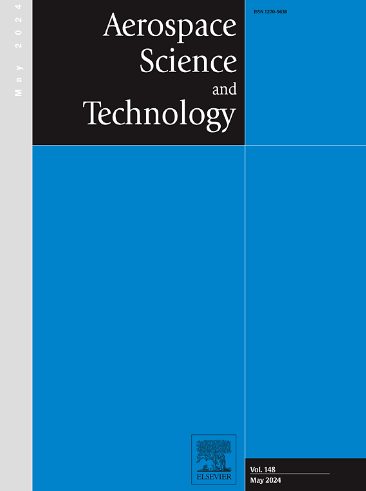Effect of local concave non-axisymmetric endwall profiling on endwall secondary flows of a highly-loaded turbine cascade
IF 5
1区 工程技术
Q1 ENGINEERING, AEROSPACE
引用次数: 0
Abstract
Non-axisymmetric endwall profiling (NAEP) has been widely utilized in reducing secondary flow loss of turbines. However, most of NAEP are designed for the endwall of the entire blade passage, which presents challenges to the design of cooling structures of turbine endwall. This study aims to explore the local concave non-axisymmetric endwall profiling (LCNP) method with the same effect as whole passage NAEP, and reveal the influence mechanism of LCNP on endwall secondary flow structures of a highly-loaded turbine cascade. Under the condition that the maximum depth of LCNP is unchanged, the axial length effect and pitchwise location effect of LCNP are studied, the influence mechanism of LCNP on the secondary flow loss is analyzed, and the genetic algorithm is utilized to optimize LCNP at the optimal position. Results show that as the axial length of the LCNP increases and the pitchwise location gets closer to the suction surface, the intensity and range of the passage vortex are decreased, and the total pressure loss coefficient (loss coefficient) of the turbine cascade is decreased. When LCNP is 100% axial chord in length and at the position of 2/9 pitch, the loss coefficient is reduced by 5.49%. LCNP was optimized at the optimal position, and the optimal LCNP reduced the loss coefficient of the turbine cascade by 6.73%. After the local concave endwall profiling, the loading in the middle of the endwall of the turbine cascade is reduced, and the intensity of the passage vortex is effectively inhibited, which is the mechanism that the loss coefficient of the turbine cascade is reduced. However, after the local concave endwall profiling, the loading in the trailing of the endwall of the turbine cascade is increased, the transverse migration of the new boundary layer in the endwall is accelerated, and the loss coefficient of the near endwall is increased.
局部凹面非轴对称端壁剖面对高负荷涡轮级联端壁二次流的影响
非轴对称端壁仿形(NAEP)已被广泛用于减少涡轮机的二次流损失。然而,大多数非轴对称端壁剖面都是针对整个叶片通道的端壁设计的,这给涡轮机端壁冷却结构的设计带来了挑战。本研究旨在探索具有与全叶片通道NAEP相同效果的局部凹面非轴对称端壁剖面(LCNP)方法,并揭示LCNP对高负荷水轮机级联端壁二次流结构的影响机理。在 LCNP 最大深度不变的条件下,研究了 LCNP 的轴向长度效应和螺距位置效应,分析了 LCNP 对二次流损失的影响机理,并利用遗传算法优化 LCNP 的最佳位置。结果表明,随着 LCNP 轴向长度的增加和桨距位置越来越靠近吸气面,通道涡流的强度和范围减小,涡轮级联的总压力损失系数(损失系数)减小。当 LCNP 轴向弦长为 100%,且位于 2/9 节距位置时,损耗系数降低了 5.49%。LCNP 在最佳位置进行了优化,最佳 LCNP 使涡轮级联的损耗系数降低了 6.73%。局部端壁凹面仿形后,水轮机级联端壁中部的载荷减小,通道涡流强度得到有效抑制,这是水轮机级联损耗系数降低的机理。然而,局部凹形端壁剖分后,水轮机级联端壁尾部的载荷增加,端壁新边界层的横向迁移加快,近端壁的损耗系数增大。
本文章由计算机程序翻译,如有差异,请以英文原文为准。
求助全文
约1分钟内获得全文
求助全文
来源期刊

Aerospace Science and Technology
工程技术-工程:宇航
CiteScore
10.30
自引率
28.60%
发文量
654
审稿时长
54 days
期刊介绍:
Aerospace Science and Technology publishes articles of outstanding scientific quality. Each article is reviewed by two referees. The journal welcomes papers from a wide range of countries. This journal publishes original papers, review articles and short communications related to all fields of aerospace research, fundamental and applied, potential applications of which are clearly related to:
• The design and the manufacture of aircraft, helicopters, missiles, launchers and satellites
• The control of their environment
• The study of various systems they are involved in, as supports or as targets.
Authors are invited to submit papers on new advances in the following topics to aerospace applications:
• Fluid dynamics
• Energetics and propulsion
• Materials and structures
• Flight mechanics
• Navigation, guidance and control
• Acoustics
• Optics
• Electromagnetism and radar
• Signal and image processing
• Information processing
• Data fusion
• Decision aid
• Human behaviour
• Robotics and intelligent systems
• Complex system engineering.
Etc.
 求助内容:
求助内容: 应助结果提醒方式:
应助结果提醒方式:


